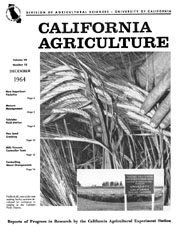


University of California
California Agriculture
|
|||
|
|||

Firlbeck III, one of the new malting barley varieties developed for resistance to lodging at the Tulelake Field Station.
December 1964
Volume 18, Number 12 General Information |
|||
|
University of California, 1301 S. 46th St., Bldg. 478 Richmond, CA
|